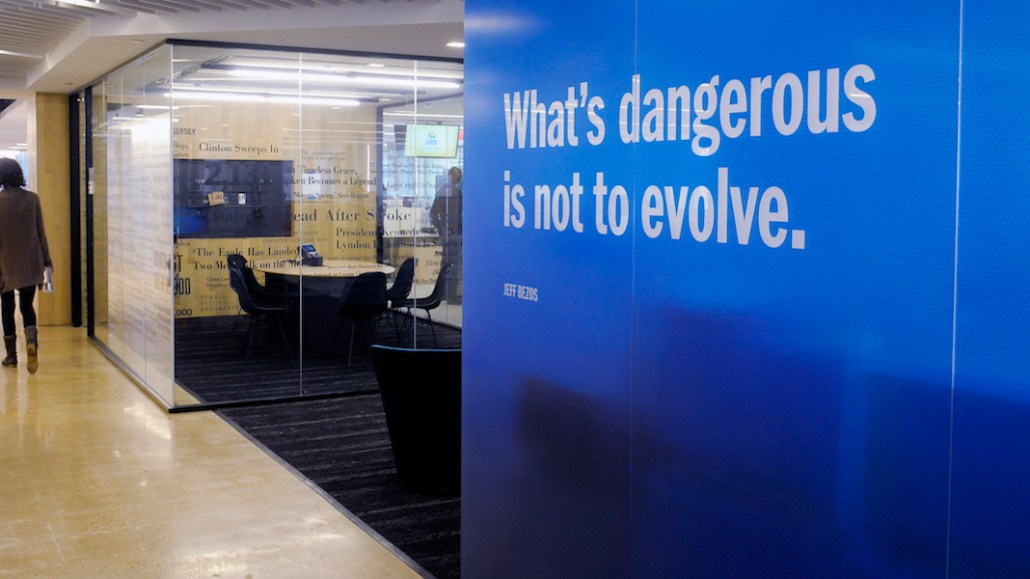
For U.S. publishers expanding internationally, one of the biggest challenges is brand perception. Encouraging agencies across markets to spend budget with news brands that are globally respected yet not regarded as go-to environments for local or non-U.S. campaigns is a time-consuming process. But The Washington Post is in it for the long game.
Under Amazon founder Jeff Bezos’ ownership, the publisher has created an engineering army and its own technology infrastructure called Arc. That’s given the Post more control over load speeds and better visibility into its users, what stories they read and their preferences for video or photo-led content — information that’s fed back to the newsroom. Arc has also opened up new revenue streams, with the Post selling the tech to other publishers including Toronto’s The Globe and Mail and the Los Angeles Times. Arc is now attracting interest from European countries, with conversations happening with major publishers in Spain and Sweden, according to Jed Hartman, the Post’s chief revenue officer.
The Post has worked on altering the perception of its brand in its domestic market, too. “In the U.S., a lot of people used to think of us as a Washington, D.C., politics title. It’s taken several years to break that perception, but only 5 percent of our audience is actually in Washington,” said Hartman. “Our reputation hasn’t caught up to the facts.”
The title wants to increase both international digital subscriptions and advertising revenue. Building its overseas audience, powered by its fast-loading distribution platform, will in time fuel subscriptions and advertising, Hartman said. The Post said it generates over $100 million from digital advertising globally and claims it has 90 million monthly unique users in the U.S. and 30 million internationally. That scale afforded it the freedom to tinker with its metered paywall, Hartman said. “We’re optimizing it [the paywall] in the U.S., and then we’ll begin to roll it out around the world, in a way that’s in line with the new General Data Protection Regulation,” he added. The Post has 1 million digital-only publications globally, a figure it doesn’t break out by country.
Over the last year, the Post has heavily marketed its daily WorldViews newsletter, which puts an international lens on news and analysis on political outcomes from Washington and is led by stories such as “Ditching deals has become Trump’s main foreign policy.” There are also plans to deeply cover areas like the World Economic Forum in Davos via newsletters to further build its audience and, ultimately, subscriptions.
On the advertising side, it’ll likely take longer to build its reputation as a global news brand. “It can be a case of talking to one client, one agency at a time, to really change perception,” said Hartman. “That’s not the most efficient way, perhaps, but it’s the most effective, as long as we have the content to support it. By pushing out more content, that will help raise awareness with the agencies.”
The Post has had skeleton sales staffs in countries like the U.K., France and Singapore, relying on local sales houses to drive its advertising revenue, which has been a mix of programmatic and direct sales. But it has just hired its first London brand studio executive to build out the branded-content studio for Europe advertisers — an area of the business that has until now been handled solely in the U.S.
Ad position: web_incontent_pos1
One of the big points of focus in the next six months will be ensuring major brands in the energy, banking and financial sectors recognize the size of the Post’s platform and feel assured their ads will be served in a fast, non-intrusive, brand-safe environment. “Internationally, we’ve been more of a transactional ad seller, but we want to become more of a content solutions provider,” said Hartman. “That’s our pivot.”
Hartman will speak in-depth at Digiday’s Publishing Summit Europe in Berlin on Oct. 24 about how to build a sustainable business model for serious news.
More in Media

NewFronts Briefing: Samsung, Condé Nast, Roku focus presentations on new ad formats and category-specific inventory
Day two of IAB’s NewFronts featured presentations from Samsung, Condé Nast and Roku, highlighting new partnerships, ad formats and inventory, as well as new AI capabilities.

The Athletic to raise ad prices as it paces to hit 3 million newsletter subscribers
The New York Times’ sports site The Athletic is about to hit 3 million total newsletter subscribers. It plans to raise ad prices as as a result of this nearly 20% year over year increase.

NewFronts Briefing: Google, Vizio and news publishers pitch marketers with new ad offerings and range of content categories
Day one of the 2024 IAB NewFronts featured presentations from Google and Vizio, as well as a spotlight on news publishers.
Ad position: web_bfu



